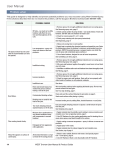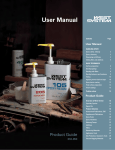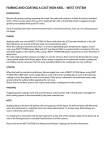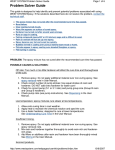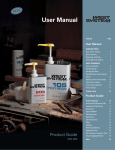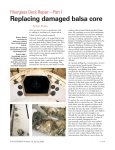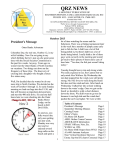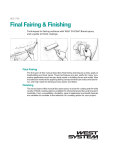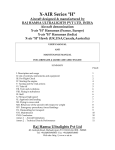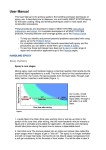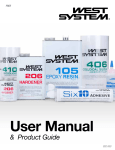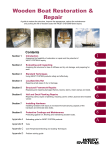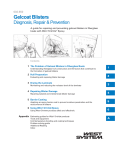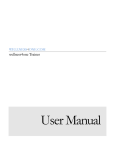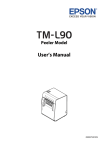Download User Manual 2008
Transcript
Product Guide WEST SYSTEM epoxy products make up a versatile epoxy system that can be used for everything from basic long-lasting repairs to the construction of high-performance composite structures. Select the products that allow you to tailor the epoxy to your working conditions and application. Product Selection Getting Started This is a basic epoxy tool kit, a list of the most commonly used products for general repair and construction. You can add to or modify the list as your job requires. Refer to the Product Guide for detailed product information. o 105 Resin This Product/Application Overview shows how bonding, filling and coating applications are related to combinations of specific products. Mix with one of four W Add one of six W S Start with 105 Resin, Hardeners. Se- 3 fillers to thicken the mixture as 1 the basic ingredient 2 S S ep- lect a hardener for its in- needed. Select a filler for its hanof all W EST EST YSTEM YSTEM oxy compounds. Use 300 Mini Pumps for convenient and accurate metering. tended use and for the cure speed best suited for your job in the temperature range in which you are working. Select Group Size A, B, or C (see coverage chart, page 18.) o Hardener 205 for general use, or 206 for extra working time/warmer temperatures 209 for high temperatures 207 for clear finishes (select a Group Size to match resin, see detailed hardener descriptions, page 19.) o 300 Mini Pumps For convenient metering o Filler (thickener) As needed 406 Adhesive Filler for general structural bonding/gap filling, or 407 Fairing Filler for sandable surface filling/fairing (see detailed filler descriptions, page 22.) o Application tools As needed Typical hardware products or recycled household items can be used for some application tools. Use 800 Roller Covers for a smooth coating. (see detailed tool descriptions, page 26.) o Instruction The publications shown on page 17 provide detailed instructions for building and repair. For additional help with specific projects contact the Gougeon technical staff, 866-937-8797 (toll free). 16 EST YSTEM WEST SYSTEM User Manual & Product Guide dling characteristics or cured physical properties. Or, add one of four WEST SYSTEM additives to provide specific coating properties. Product Guide Instruction 002 The Gougeon Brothers on Boat Construction 002-150 Vacuum Bagging Techniques Decades of experience building with wood and epoxy are compiled in this classic on wood/epoxy boatbuilding. Extensive chapters on lofting, safety, tools and construction methods are described with the aid of hundreds of detailed illustrations and photographs. This 5th edition includes about 20% new and updated material and a revised layout for easier navigation. Used as a textbook in boatbuilding schools. Over 100,000 copies in print. Hardcover—406 pages. A definitive guide to the principles and application of vacuum bagging techniques for laminating composite materials with epoxy. Complete instructions describe various techniques; materials and equipment. Softcover—52 pages. 002-970 Wooden Boat Restoration & Repair This manual shows you how to do professional level repairs and renovations that dramatically extend the life of your wooden boat. Dry rot repairs, structural frame repairs, and plank repairs using modern products and techniques are among the many solutions covered in this fully illustrated manual. Softcover—80 pages. 002-550 Fiberglass Boat Repair & Maintenance This is a complete, illustrated guide to a variety of fiberglass repair problems, including detailed instructions on repairing cracks and holes, delamination, rot and keel damage. It also covers fairing keels, hardware bonding, finishing and installing teak veneers. Softcover—84 pages. 002-650 Gelcoat Blisters: Diagnosis, Repair & Prevention This manual provides a thorough explanation of osmotic blistering, and detailed, illustrated instructions on effective laminate drying techniques, repairing localized and severe interlaminate blister damage, techniques for applying an effective epoxy barrier coat and more. Softcover—52 pages. 002-740 Final Fairing & Finishing This guide takes you through the final steps of the building or repair process in detail. Includes techniques for fairing and barrier coating, as well as information on the characteristics and types of finishing coatings. Softcover—28 pages. 002-898 WEST SYSTEM Epoxy How-To DVD A compilation of three instructional videos demonstrating basic handling and advanced epoxy repair techniques. Basic Application Techniques—A guide to the optimum use of WEST SYSTEM epoxy products, including epoxy safety and procedures for coating, bonding and fairing. Fiberglass Repair with WEST SYSTEM Epoxy—Using WEST SYSTEM epoxy to make structural repairs on fiberglass boats, including repairs to cored and non-cored hulls and how to apply gelcoat over epoxy repairs. Gelcoat Blister Repair with WEST SYSTEM Epoxy—A guide for repairing and preventing gelcoat blisters on fiberglass boats. Analyzing the causes of blister formation, preparing and drying fiberglass hulls, and repairing and coating for moisture protection with WEST SYSTEM epoxy. Interactive menus allow for easy navigation through these subjects. DVD—59 minutes. Supplemental Publications 000-605 EPOXYWORKS FREE (USA and Canada only) three-year (6 issues) subscription to the semiannual magazine published by Gougeon Brothers Inc. Discusses boat building, restorations, repairs, events, interesting projects, the latest techniques and helpful tips related to epoxy. Articles highlight readers projects and news from our test labs. Subscribe to EPOXYWORKS by writing or calling Gougeon Brothers, or visit www.westsystem.com. You can also view EPOXYWORKS on line at www.epoxyworks.com. 002-960 Technical Data Package The Technical Data Package, available free upon request, includes the following publications: 000-574 Epoxy Safety, 000-742 Quality Assurance Considerations, 000-7105 WEST SYSTEM Epoxy Physical Properties, 000-800 Thinning WEST SYSTEM Epoxy, 000-915 Cold Temperature Bonding and Coating with Epoxy, 000-545 Fatigue, 000-745 Moisture Exclusion Effectiveness (MEE). Material Safety Data Sheets MSDS for specific WEST SYSTEM products are available at www.westsystem.com, through WEST SYSTEM distributors or by contacting Gougeon Brothers Inc. For additional information about the use or suitability of WEST SYSTEM products contact the Gougeon Technical Staff at 866-937-8797. WEST SYSTEM User Manual & Product Guide 17 Product Guide WEST SYSTEM epoxy cures to a high-strength plastic solid at room temperatures, by mixing specific proportions of liquid epoxy resin and hardener. This highly moisture-resistant plastic adheres to a wide range of materials, making it ideal for projects that require water and chemical resistence, and strong physical properties for structural bonding. Select from a range of hardeners and additives that allow you to tailor the mixture’s handling characteristics and the physical properties of the cured epoxy to suit your working conditions and specific coating or bonding application. Epoxy Resin 105 Epoxy Resin 105 Resin is the base material of the WEST SYSTEM compounds are built. The resin is a clear, pale yellow, low-viscosity liquid epoxy resin. Formulated for use with WEST SYSTEM hardeners, it can be cured in a wide temperature range to form a high-strength solid with excellent moisture resistance. 105 Resin is formulated without volatile solvents and does not shrink after curing. It has a relatively high flash point and no strong solvent odor, making it safer to work with than polyester or vinylester resins. Resin viscosity is approximately 1000 centipoise (cP) at 72°F (22°C). 105 Resin is designed specifically to wet out and bond with wood fiber, fiberglass, reinforcing fabrics and a variety of metals when mixed at the proper ratio with a WEST SYSTEM Group size quantities and coating coverage WEST SYSTEM epoxy resin and hardeners are packaged in three “Group Sizes.” For each container size of resin, there is a corresponding sized container of hardener. When purchasing resin and hardener, be sure both containers are labeled with the same Group Size letter (A, B or C). hardener. An excellent adhesive, 105 mixtures will bridge gaps and fill voids when modified with WEST SYSTEM fillers and can be sanded and shaped when cured. With roller applications, it has excellent thin-film characteristics to flow out and self-level without “fisheyeing.” 105 Resin/207 Hardener mixtures cure clear so you can achieve a natural finish when coating with varnish. Estimated epoxy coverage for fabric application Fabric Product number (see page 24) Fabric weight per yd2 Saturation coat single fabric layer* (see page 10) Fill coats 2–3 coats required (see page 11) 740 4 oz 29 ft2/lb 35 ft2/lb 742 6 oz 20 ft2/lb 33 ft2/lb 729, 731, 732, 733 9 oz 13 ft2/lb 31 ft2/lb 745 12 oz 10 ft /lb 28 ft2/lb 727, 737 17 oz 8 ft2/lb 26 ft2/lb 23.8 oz 5 ft2/lb 20 ft2/lb 738 * includes 20% waste factor. (see chart below for Group Size mixed quantity in pounds) COATING COVERAGE PACKAGE SIZE/QUANTITY Resin/Hardener Group Resin quantity Group Size A 105-A 1 qt (.94 L) 2.40 lb Group Size B 105-B .98 gal (3.74 L) 9.50 lb Group Size C 105-C 4.35 gal (16.47 L) 41.82 lb 18 2 Hardener quantity Mixed quantity Saturation coat porous surfaces Buildup coats non-porous surfaces 205-A or 206-A .43 pt (.20 L) .47 lb 1.2 qt (1.15 L) 2.87 lb 90–105 ft2 (8.5–10m2) 120–135 ft2 (11–12.5 m2) 207-A or 209-A .66 pt (.31 L) .70 lb 1.3 qt (1.26 L) 3.1 lb 90–105 ft2 (9–10 m2) 120–135 ft2 (11–13 m2) 205-B or 206-B .86 qt (.81 L) 1.86 lb 1.2 gal (4.55 L) 11.36 lb 350–405 ft2 (32–37 m2) 462–520 ft2 (43–48 m2) 207-B or 209-B 1.32 qt (1.24 L) 2.75 lb 1.3 gal (4.98 L) 12.25 lb 370–430 ft2 (35–40 m2) 490–550 ft2 (45–50 m2) 205-C or 206-C .94 gal (3.58 L) 8.20 lb 5.29 gal (20 L) 50.02 lb 1530–1785 ft2 (142–165 m2) 2040–2300 ft2 (190–213 m2) 207-C or 209-C 1.45 gal (5.49 L) 12.0 lb 5.8 gal (21.9 L) 53.82 lb 1675–1955 ft2 (155–180 m2) 2235–2520 ft2 (207–233 m2) WEST SYSTEM User Manual & Product Guide Product Guide Hardener Selection Guide Select a hardener for its intended use and for the cure speed best suited for your job in the temperature range in which you are working. HARDENER TEMPERATURE RANGE (°F) HARDENER USES Resin/Hardener 205 General bonding, fabric application and barrier coating General bonding, fabric application and barrier coating Clear fabric application and clear coating for a natural wood finish General bonding, fabric application and barrier coating Room Temp. 40° 206 207 209 50° 60° 70° 80° 90° 100° CURE SPEEDS at room temp.* POT LIFE 100g cupful WORKING TIME thin film CURE TO SOLID thin film 9–12 60–70 6–8 minutes minutes hours 10–15 20–25 90–110 minutes minutes hours 22–27 110–130 12–18 minutes minutes hours 40–50 3–4 20–24 minutes hours hours *Epoxy cures faster in warmer temperatures and in thicker applications—Epoxy cures slower in cooler temperatures and in thinner applications. Epoxy Hardeners 5:1 Ratio 205 Fast Hardener 206 Slow Hardener 205 Fast Hardener is a medium-viscosity epoxy curing agent. It is used in a majority of situations, at lower temperatures and to produce a rapid cure that develops its physical properties quickly at room temperature. When mixed with the 105 Resin in a five-part resin to one-part hardener ratio, the cured resin/hardener mixture yields a rigid, high-strength, moisture-resistant solid with excellent bonding and coating properties. Not intended for clear coating. Pot life at 72°F (22°C) . . . . . . . . . . 9 to 12 minutes Cure to a solid state . . . . . . . . . . . . . 6 to 8 hours Cure to maximum strength . . . . . . . . . . 1 to 4 days Minimum recommended temperature . . . . 40°F (4°C) 206 Slow Hardener is a low-viscosity epoxy curing agent for use when extended working and cure time is needed or to provide adequate working time at higher temperatures. When combined with 105 Resin in a five-part resin to one-part hardener ratio, the cured resin/hardener mixture yields a rigid, high-strength, moisture-resistant solid with excellent bonding and coating properties. Not intended for clear coating. Pot life at 72°F (22°C). . . . . . . . . . 20 to 25 minutes Cure to a solid state . . . . . . . . . . . . 10 to 15 hours Cure to maximum strength . . . . . . . . . . 1 to 4 days Minimum recommended temperature . . . . 60°F (16°C) Epoxy Hardeners 3:1 Ratio 207 Special Coating Hardener 209 Extra Slow Hardener 207 Special Coating Hardener was developed for coating and fiberglass cloth application where an exceptionally clear, moisture-resistant, natural wood finish is desired. WEST SYSTEM 105/207 mixtures resist clouding in humid conditions and exhibit extremely low blush formation—as low as any epoxy you will find anywhere, including so-called “no blush” epoxies. Professional and first-time builders like 207 because it is reliable and easy to use. Three coats or more can be applied in one day without additional surface preparation. Fewer coats are required to fill fiberglass weave and in most cases the final coating can be sanded the following day. Boats can be built faster. Builders also appreciate the excellent fiberglass wet-out characteristics achieved with 105/207, yet it won’t drain from vertical surfaces like the very slow curing, low-viscosity epoxies. 105/207 has strong physical properties, so it can be used as a structural adhesive for gluing and laminating. It has excellent compatibility with paints and varnishes. An ultraviolet inhibitor in 207 helps provide a beautiful, long lasting finish when used with quality UV-filtering varnish. 105/207 cures to a light amber color, similar to traditional spar varnishes. Pot life at 72°F (22°C). . . . . . . . . . 22 to 27 minutes Cure to a solid state . . . . . . . . . . . . 12 to 18 hours Cure to maximum strength . . . . . . . . . . 4 to 7 days Minimum recommended temperature . . . . 60°F (16°C) 209 Extra Slow Hardener is formulated for general coating and bonding applications in extremely warm and/or humid conditions or when extended working time is desired at room temperature. Provides approximately twice the working time of 206 Slow Hardener. Forms a clear, amber-colored solid with good physical properties and moisture resistance for bonding and coating applications. Not intended for clear coating. Pot life at 72°F (22°C). . . . . . . . . . 40 to 50 minutes at 95°F (35°C). . . . . . . . . . 15 to 20 minutes Cure to a solid state at 72°F (22°C) . . . . 20 to 24 hours at 95°F (35°C) . . . . . 6 to 8 hours Cure to maximum strength at 72°F . . . . . . 4 to 9 days Minimum recommended temperature . . . . 70°F (21°C) Storage/Shelf life Store at room temperature. Keep containers closed to prevent contamination. With proper storage, resin and hardeners should remain usable for many years. Over time, 105 Resin will thicken slightly and will therefore require extra care when mixing. Repeated freeze/thaw cycles during storage may cause crystallization of 105 Resin. Warm resin to 125°F and stir to dissolve crystals. Hardeners may darken with age, but physical properties are not affected by color. After a long storage,verify the metering accuracy of the pumps and mix a small test batch to assure proper curing. WEST SYSTEM User Manual & Product Guide 19 Product Guide Metering Pumps 300 Mini Pump Set Large Capacity Pumps 300 Mini Pumps are designed for convenient and accurate metering of Group Size A, B and C WEST SYSTEM 105 Resin-based epoxy. The 300 Mini Pump Set contains one resin pump and two hardener pumps. Pumps mount directly on the resin and hardener containers and eliminate the mess involved with measuring by weight or volume. 300 Mini Pumps are calibrated to deliver the proper working ratio with one full pump stroke of resin for each one full pump stroke of hardener. 105/205-206 pumps deliver approximately 0.8 fl oz of resin/hardener with one full stroke of each pump. 105/207-209 pumps deliver approximately 0.9 fl oz of resin/hardener with one full stroke of each pump. As packaged, the pumps are ready to install on the Group Size B containers. A package of extension tubes for Group Size A containers is included with the set. Group Size C extension tubes are included in the 105-C Resin and in the 207-SC or 209-SC packages. Made of durable polypropylene, the pumps give years of dependable service. Read and follow the priming, ratio verification and operating instructions that come with the pumps. 306-25 Metering Pump 306-23 Metering Pump Similar to 306-25 Metering Pump described above. For metering 105 Resin and 207 Special Coating or 209 Extra Slow (3:1 ratio) Hardeners. Can be converted to 5:1 ratio. 306-K235 Rebuild Kit For 306-25 (5:1) ratio and 306-23 (3:1) ratio pumps. Includes seals, balls, gaskets, springs, high-rise tubes with ferrules and new resin and hardener reservoirs with lids. 306-K and 306-3K Rebuild Kits for older model 306 (single body) dispensing pumps. 309 High-Capacity Gear Pump Metering scale 320 Small-Batch Epoxy Scale For batches smaller than one Mini Pump stroke, the 320 scale accurately measures the correct ratio of resin and hardener from 4.4 fl oz down to just a few drops of mixed product. The scale can also be used to confirm the accuracy of your WEST SYSTEM dispensing pumps and to consistently add pigments or other additives. The scale comes in a convenient kit for small projects. The kit includes dispensing bottles, 3¼ oz and 1 oz plastic mixing cups, mixing sticks, and pipe cleaners. 20 For metering larger quantities of 105 Resin and 205 or 206 (5:1 ratio) Hardeners. The 306-25 Pump will reduce mixing time and waste on large projects. A carrying handle allows you to move the pump where the works is. Reservoirs hold one gallon of resin, one quart of hardener. Dispenses approximately 0.5 fl oz of resin/hardener per pump stroke (about 1 qt per minute). Can be converted to a 3:1 ratio. For use with 205 or 206 (5:1 ratio) Hardeners. The 309 Gear Pump is designed and built by Gougeon Brothers for large projects and manufacturing operations. The home builder and professional alike will enjoy the efficiency of this high-volume pump. With continuous rotation of the crank, the metered resin and hardener can be delivered at up to five quarts per minute. Positive shutoff prevents resin and hardener loss through dripping spouts. The convenient handle makes it easy to carry the pump to right where it’s needed. Stainless steel reservoirs hold two gallons of resin, one gallon of hardener. 309-3 High-Capacity Gear Pump Similar to 309 High-Capacity Gear Pump described above. For metering 105 Resin and 207 Special Coating or 209 Extra Slow (3:1 ratio) Hardeners. WEST SYSTEM User Manual & Product Guide Product Guide Repair Packs 101 Handy Repair Pack Here is everything you need to complete small repairs around the boat, shop or home. The Handy Repair Pack contains two WEST SYSTEM 105 Resin/205 (fast) Hardener packets, and enough adhesive filler to complete a variety of coating and bonding operations. Also included are a 2" × 10" piece of 9 oz fiberglass tape (useful for patching, reinforcing or abrasion resistance), an application brush, mixing stick, pipe cleaner, two cleaning pads and complete instructions. The components can be mixed in the disposable package. 101-6 Maxi Repair Pack The Maxi Repair Pack contains six 105 Resin/205 Hardener packets, an easy sanding fairing filler for surface filling and a high-density adhesive filler for bonding. Use the 4" × 12" piece of 9 oz fiberglass tape for patching holes, reinforcing joints or providing abrasion resistance to wear surfaces. Also included are two application brushes, one syringe, two pipe cleaners, four mixing sticks, one pair of disposable gloves, four cleaning pads, mixing cups and illustrated instructions. 101-T Six resin/hardener packets only. Each pre-measured packet contains 16g of 105 Resin and 3.2g of 205 (fast) Hardener (19.2g or 0.56 fl oz of mixed epoxy). More information If you have any questions about selecting or using WEST SYSTEM products that are not answered in this manual, you are encouraged to contact the Gougeon Brothers technical staff. Call 866-937-8797 toll free or visit www.westsystem.com, where you can fill out a form and receive an emailed response to your question. Specialty Epoxies G/flex® Epoxy G/flex Epoxy is a toughened, resilient two-part epoxy engineered for a superior grip to metals, plastics, glass, masonry, fiberglass, and wet and difficult-to-bond woods. Make structural bonds that absorb the stresses of expansion, contraction, shock and vibration. It has an easy-to-use 1:1 mix ratio and gives you 46 minute pot life and a long open or working time of 75 minutes at room temperature. It will reach an initial cure in 3–4 hours and a workable cure in 7–10 hours. G/flex is available in two consistencies. 650 Epoxy is a versatile easily-modified liquid epoxy. 655 Epoxy Adhesive is a convenient pre-thickened epoxy. 650-8 Includes 4 fl oz G/flex 650 Resin, 4 fl oz G/flex 650 Hardener (8 fl oz of mixed epoxy), and handling and repair instructions. 650-K Kit contains 4 fl oz G/flex 650 Resin, 4 fl oz G/flex 650 Hardener (8 fl oz of mixed epoxy), 2 reusable mixing stick/applicators, 2 12 cc syringes, 4g of adhesive filler, 4 mixing cups, 1 pair of disposable neoprene gloves, 4 alcohol cleaning pads, and complete handling and repair instructions. 655-K Kit contains 4.5 fl oz G/flex 655 Resin, 4.5 fl oz G/flex 655 Hardener (9 fl oz mixed epoxy), 2 reusable mixing stick/applicators, 4 alcohol cleaning pads, 1 pr disposable neoprene gloves, 10 mixing palettes, and complete handling and repair instructions. G/5 Five-Minute Adhesive An easy to use, fast curing epoxy system for quick repairs, tooling and general bonding. May be used in spot applications to hold parts in position while standard epoxy bonds cure. Bonds to wood, fiberglass and metal. One-to-one mixture, no pumps are required. Cures in 3-5 minutes. 865-4 4 fl oz resin/4 fl oz hardener. 865-16 16 fl oz resin/16 fl oz hardener. WEST SYSTEM User Manual & Product Guide 21 Product Guide Fillers Adhesive Fillers Fairing Fillers 403 Microfibers 407 Low-Density Filler 403 Microfibers, a fine fiber blend, is used as a thickening additive that builds volume quickly and blends easily to create a multipurpose adhesive, especially for bonding wood. Epoxy thickened with Microfibers has good gap-filling qualities while retaining excellent wetting/penetrating capability. Cures to an off-white color. 407 Low-Density Filler is a blended microballoon-based filler used to make fairing putties that are easy to sand or carve. Reasonably strong on a strength-to-weight basis. Cures to a dark red/brown color. 404 High-Density Filler 404 High-Density Filler is a thickening additive developed for maximum physical properties in hardware bonding where high-cyclic loads are anticipated. It can also be used for filleting and gap-filling where maximum strength is necessary. Cures to an off-white color. 405 Filleting Blend This strong, wood-toned filler is good for use in glue joints and fillets on naturally-finished wood. It mixes easily with epoxy and has good gap-filling properties. It cures to a dark brown color, and can be used to modify the color of other WEST SYSTEM fillers. 406 Colloidal Silica 406 Colloidal Silica is a thickening additive used to control the viscosity of the epoxy and prevent epoxy runoff in vertical and overhead joints. 406 is a very strong filler that creates a smooth mixture, ideal for general bonding and filleting. It is also our most versatile filler. Often used in combination with other fillers, it can be used to improve the strength, abrasion resistance, and consistency of fairing compounds, resulting in a tougher, smoother surface. Cures to an off-white color. 22 410 Microlight™ 410 Microlight™ is the ideal low-density filler for creating a light, easily-worked fairing compound especially suited for fairing large areas. Microlight™ mixes with greater ease than 407 Low-Density Filler or microballoons and is approximately 30% easier to sand. It feathers to a fine edge and is also more economical for large fairing jobs. Not recommended under dark paint or other surfaces subject to high temperatures. Cures to a light tan color. Adhesive Fillers vs. Fairing Fillers Fillers are used to thicken the basic resin/hardener mixture for specific applications. Each filler possesses a unique set of physical characteristics, but they can be generally categorized as either Adhesive (high-density) or Fairing (low-density). Adhesive filler mixtures cure to a strong, hard-to-sand plastic useful in structural applications like bonding, filleting and hardware bonding. Fairing filler mixtures cure to light, easily sandable material that is generally used for cosmetic or surface applications like shaping, filling or fairing. Seal all faired surfaces with epoxy before painting. The Filler Selection Guide on the following page compares the suitability of fillers for various uses. The Filler Buying Guide gives package sizes and quantities for various consistencies. WEST SYSTEM User Manual & Product Guide Product Guide Filler Information Filler Selection Guide ADHESIVE FILLERS FAIRING FILLERS Highest density Highest strength Uses—Use description—desired characteristics (Resin/Hardener mixture thickened with a Filler) 404 Lowest density Easiest sanding 406 High-Density Colloidal Silica Bonding Hardware—Increased fastener interface and hardware load capability—maximum strength 403 Microfibers 405 407 Filleting Blend Low-Density HHHH HHH HHH HH General Bonding—Join parts with epoxy thickened to create a structural gap filler—strength/gap filling HHH HHH HHH HH H Bonding with Fillets—Increase joint bonding area and create a structural brace between parts—smoothness/strength HH HHHH HH HHH HHH Laminating—Bond layers of wood strips, veneers, planks, sheets and cores—gap filling/strength HH HHH HHHH HH HH Fairing—Fill low areas and voids with an easily sanded surface filler/fairing compound—sandability/gap filling HHH 410 Microlight™ HHHH Filler suitability for various uses HHHH=excellent, HHH=very good, HH=good, H=fair, (no stars)=not recommended. Selecting Fillers As a rule, use higher-density fillers when bonding higher-density materials such as hardwoods and metals. Any of the adhesive fillers are suitable for most bonding situations. Your choice of a filler for general use may be based on the handling characteristics you prefer. Fillers may also be blended to create mixtures with intermediate characteristics. Filler Buying Guide Approximate mixed epoxy required to produce a catsup, mayonnaise or peanut butter consistency for the various sized filler products at 72°F. Mixtures may require more filler/less epoxy at higher temperatures. See Figure 4 on page 5. Quantity of mixed epoxy required for Filler Package size 403-9 403-28 403-B catsup consistency mayonnaise consistency peanut butter consistency 6.0 oz 20.0 oz 20.0 lb 3.8 qt 3.2 gal 48.0 gal 2.5 qt 2.0 gal 32.0 gal 1.0 qt .9 gal 15.3 gal 404-15 404-45 404-B 15.2 oz 43.0 oz 30.0 lb 1.2 qt 3.6 qt 9.4 gal .9 qt 2.8 qt 7.4 gal .7 qt 2.0 qt 5.3 gal 405 8.0 oz .9 qt .7 qt .6 qt 406-2 406-7 406-B 1.7 oz 5.5 oz 10.0 lb 1.3 qt 1.1 gal 27.0 gal .9 qt 3.0 qt 16.0 gal .5 qt 1.7 qt 6.0 gal 407-5 407-15 407-B 4.0 oz 12.0 oz 14.0 lb .5 qt 1.7 qt 6.0 gal .4 qt 1.3 qt 4.8 gal .3 qt 1.0 qt 3.7 gal 410-2 410-7 410-B 2.0 oz 5.0 oz 4.0 lb 1.2 qt 3.0 qt 8.9 gal .9 qt 2.4 qt 7.2 gal .7 qt 1.8 qt 5.6 gal Supplemental epoxy information Thinning epoxy There are epoxy-based products specifically designed to penetrate and reinforce rotted wood. These products, basically an epoxy thinned with solvents, do a good job of penetrating wood. But the solvents compromise the strength and moisture barrier properties of the epoxy. WEST SYSTEM epoxy can be thinned with solvents for greater penetration, but not without the same compromise in strength and moisture resistance. Acetone and lacquer thinner have been used to thin WEST SYSTEM epoxy and duplicate these penetrating epoxies with about the same effectiveness. If you chose to thin the epoxy, keep in mind that the strength, especially compressive strength, and moisture protection of the epoxy are lost in proportion to the amount of solvent added. There is a better solution to get good penetration without losing strength or moisture resistance. We recommend moderate heating (up to 120°F) of the repair area with a heat gun or heat lamp before applying epoxy. On contact with the warmed wood, the epoxy will thin out, penetrating cavities and pores, and will be drawn even deeper into pores as the wood cools. Although the working life of the epoxy will be considerably shortened, slower hardeners (206, 207, 209) will have a longer working life and should penetrate more than 205 Hardener before they begin to gel. When the epoxy cures it will retain all of its strength and effectiveness as a moisture barrier, which we feel more than offsets any advantages gained by adding solvents to the epoxy. Low temperature considerations When using WEST SYSTEM Epoxy at low temperatures, special precautions can be taken to assure maximum performance. For detailed information on working with epoxy at low temperatures, refer to 000-915 Cold Temperature Bonding and Coating with Epoxy, available from Gougeon Brothers. See page 17 for information on this and other supplemental WEST SYSTEM publications. WEST SYSTEM User Manual & Product Guide 23 Product Guide Additives 420 Aluminum Powder 420 Aluminum Powder will increase the hardness and abrasion resistance of the coated surface and improve its moisture resistance. 420 provides limited protection from ultraviolet light in areas that will not be protected with other coatings and can be used as a base for subsequent painting. Cures to a metallic gray color. Add to mixed resin/hardener at the rate of 10% by volume or 1½ tablespoons per 8 fl oz of epoxy (10 strokes each of resin and hardener from 300 Mini Pumps deliver 8 fl oz of epoxy). 6 oz of 420 will modify one B group of epoxy. 420-6 6 oz, 420 16 oz. 422 Barrier Coat Additive A proprietary blend designed to improve cured epoxy’s moisture-exclusion effectiveness. 422 is used as a barrier coating additive to help prevent gelcoat blistering in polyester fiberglass boat hulls. 422 also increases the epoxy’s abrasion resistance. Cures to a light gray color. Add to mixed resin/hardener at the rate of 15 to 20% by volume or 3 tablespoons per 8 fl oz of epoxy. 32 oz of 422 will modify one B group of epoxy. 422-16 16 oz, 422-48 40 oz. 423 Graphite Powder Additives for special coating properties Additives are blended with mixed epoxy to alter the physical properties of epoxy when used as a coating. Additives can be used to alter the color, abrasion resistance or moisture resistance of cured epoxy. Color Pigments WEST SYSTEM pigments are epoxy-based liquid colorants used to tint the epoxy mixture to provide an even color base for the final finish system. The colored surfaces also tend to highlight flaws and imperfections. Cured, pigmented epoxy surfaces are not a final finish surface, but require an additional paint or UV filter coating for ultraviolet protection. Add to the mixed resin/hardener at a rate of approximately one teaspoon of pigment to 8 fl oz of epoxy. More pigment will increase opaqueness and mixture viscosity. One 4 fl oz bottle will tint approximately 1½ gal of epoxy. 501 White Pigment 4 fl oz, 503 Gray Pigment 4 fl oz. 423 Graphite Powder is a fine black powder that can be mixed with WEST SYSTEM epoxy to produce a low-friction exterior coating with increased scuff resistance and durability. Epoxy/graphite is commonly used as a low-load, low-speed bearing surface, and as a coating on rudders and centerboards, or on the bottoms of racing craft that are dry sailed. It does not provide antifouling qualities. The epoxy/graphite mixture can also be used in teak deck construction to simulate the look of traditional seams and to protect the epoxy from sunlight. Cures to a black color. Add to mixed resin/hardener at the rate of 10% by volume or 1½ tablespoons per 8 fl oz of epoxy. 5.7 oz of 423 will modify one B group of epoxy. 423-6 6 oz, 423 12 oz. Coloring epoxy For colors other than white or gray, powdered pigments (tempera paint, colored tile grout, aniline dyes) and universal tinting pigment can be added to the epoxy mixture. Acrylic paste pigments (available from marine chandleries) are also used to tint the mixture, as long as they are specified for use with polyester or epoxy resin. 423 Graphite Powder will color the epoxy black or impart darker shades to colors. Generally, coloring agents can be added to the mixed epoxy up to 5% by volume with minimal effect on the cured epoxy’s strength. Always make test samples to check for desired color and opaqueness and for proper cure. None of these coloring additives provide UV resistance to the cured epoxy, so limit their use to areas not exposed to sunlight unless additional UV protection is applied. 24 WEST SYSTEM User Manual & Product Guide Product Guide Episize™ Reinforcing Materials Unidirectional Carbon Tapes 737 Biaxial Fabric Unidirectional 11.1 oz carbon fiber reinforcing tapes are used for selective reinforcement to improve tensile strength and stiffness in one direction while adding minimum thickness and weight. Fiber bundles are held in place by a polyester fill thread for easy handling and wet out. 144,000 fibers per inch of tape width. 702-12 1½" wide × 12' roll, 702-50 1½" wide × 50' roll, 703-12 3" wide × 12' roll, 703-50 3" wide × 50' roll. 17 oz non-woven E glass fabric. Two layers, ±45° fiber orientation. For composites, repairs and reinforcing. Achieves high fiber-to-resin ratio with hand wet-out. 737-20 50" wide × 20 yd roll. 713 Unidirectional Glass Tape Unidirectional 11.1 oz E-glass fiber reinforcing tape is used to add strength in one direction, but with less stiffness than carbon fiber. Easy to handle and wet out. 713-12 3" wide × 12' roll, 713-50 3" wide × 50' roll. 727 Biaxial Tape Non-woven 17 oz E glass fabric. Two layers at a ±45° fiber orientation are held together by a light stitching. Flat, non-crimped fibers yield reduced print-through and higher stiffness than woven fabrics. Ideal for repairs, tabbing and reinforcing. 727-10 4" wide × 10' roll, 727-20 4" wide × 20 yd roll. Glass Tape Versatile WEST SYSTEM 9 oz woven fabric tapes, with bound edges, are ideal for reinforcing chines, hull/deck corners and similar structural applications. When bonded with WEST SYSTEM epoxy, they provide additional tensile strength to resist hairline crack development and abrasion. 729-10 2" wide × 10' roll, 729 2" wide × 50 yd roll, 731 3" wide × 50 yd roll, 732-10 4" wide × 10' roll, 732 4" wide × 50 yd roll, 733 6" wide × 50 yd roll. 738 Biaxial Fabric 17 oz non-woven E glass fabric. Two layers, ±45° fiber orientation. The same as 737 fabric with a .75 oz/sq ft mat backing. Approximately 23.8 oz/sq yd total fabric weight. 738-20 50" wide × 20 yd roll. Glass Fabrics Woven glass fabrics are ideal for building composite laminates and repairing fiberglass structures. May also be used to provide an abrasion-resistant covering for wooden structures. When wet-out, the 4 and 6 oz fabrics become transparent, allowing a clear, natural wood finish. Perfect for stripper canoes. May be painted or varnished. 740-10 4 oz– 50" wide × 10 yd roll, 740-20 4 oz– 50" wide × 20 yd roll, 742-10 6 oz– 60" wide × 10 yd roll, 742-20 6 oz– 60" wide × 20 yd roll, 745-10 12 oz– 60" wide × 10 yd roll, 745-20 12 oz– 60" wide × 20 yd roll, 745-30 12 oz– 30" × 30" sheet. Estimating the number of reinforcing fabric layers To determine the number of fabric layers required to achieve a specific laminate thickness, divide the thickness desired by the Single Layer Thickness of the tape or fabric you intend to use. Product number 740 Fabric weight 4 oz 6 oz 11 oz 11 oz 9 oz 12 oz 17 oz 23.8 oz Single Layer Thickness* 742 713 702 729 745 737 738 .008" .010" .012" .015" .017" .020" .035" .042" *Average of multiple layers applied by hand lay-up WEST SYSTEM User Manual & Product Guide 25 Product Guide Application Tools 800 Roller Covers Poly Mixing Pots These thin polyurethane foam covers are the only roller covers recommended for epoxy application. The thin foam allows you to control film thickness, avoid drips and runs and get a smoother coating. The 7" covers can be cut for smaller coating areas and narrower roller frames. 800-2 2 ea. Cured epoxy pops out of these heavy-duty, reusable plastic mixing pots. Convenient batch sizes for most projects. 805 16 oz pot—1 ea, 806 32 oz pot—1 ea. 807 Syringes Reusable syringes that can be loaded with epoxy mixture for injecting into tight spots. Ideal for hardware bonding and small repairs. Holds 12cc (about 0.4 fl oz). 807-2 2 ea, 807-12 12 ea. 801-HD Roller Frame Cut into segments for tipping off freshly applied coats of epoxy. Cut covers into narrower widths to coat smaller areas. 3" caged roller frame holds 7" full-width covers and covers cut to narrower widths. 1 ea. 802 Roller Pan Heavy duty, flexible plastic roller pan allows you to “pop out” epoxy after it has cured so the pan can be reused. Eliminates the need for liners. 1 ea. 803 Glue Brushes Handy, disposable, ½" × 6" glue application brushes with a metal handle. These brushes are useful in a wide variety of small bonding and coating applications. 803-12 12 ea, 803-144 144 ea. 804 Reusable Mixing Sticks A practical mixing, application, filleting, and cleaning tool. Squared, beveled end reaches mixing pot corners for thorough mixing and blending in fillers and for cleaning up excess epoxy. Use rounded end to shape 38" radius fillets. Cured epoxy pops off easily, so they can be reused many times. ¾"-wide × 5½". 804-8 8 ea, 804-60 60 ea. 26 808 Flexible Plastic Spreader Flexible, reusable 3½"× 6" double-edged spreader for flow coating, fairing, filling and applying fabrics. 808-2 2 ea, 808-12 12 ea. 809 Notched Spreader Stiff 4" × 4" plastic spreader with 18", 316" and 14 " notches on three sides for quickly applying thickened epoxy at a constant rate over large areas. Thin straight edge is ideal for applying layers of reinforcing fabrics. 809 1 ea, 809-2 2 ea. 810 Fillable Caulking Tubes For use with a standard caulking gun. Great for injecting large amounts of epoxy, laying a lengthy bead of epoxy or making fillets. Can be refilled several times, before epoxy begins to cure. Tubes can be refilled again after cured epoxy is popped out. Holds approximately 10 fl oz. 810-2 2 ea, 810-24 24 ea. Tool reusability Epoxy will not bond to many plastic tools because their glossy surface does not provide enough texture, or tooth, for epoxy to key into. When cured, flex the tool to loosen epoxy. Thick films pop off easier than thin films. As a tool gets scuffed and scratched from use, it will become more difficult to pop the cured epoxy from the surface. WEST SYSTEM User Manual & Product Guide Product Guide Skin Protection Stay clean and work safely It is much easier and safer to keep epoxy off your skin than it is to clean it off. Gloves, coveralls and sleeves help you stay clean. 830 Medicated Skin Cream Medicated skin cream to soothe minor skin irritations and help prevent dermatitis. 5 fl oz tube. 831 Protective Skin Cream A protective barrier cream to help protect skin from irritants. Use with protective gloves. 5 fl oz tube. 832 Disposable Gloves Lightweight, seamless neoprene gloves are more chemically resistant than latex gloves. They provide excellent protection while retaining good finger sensitivity and dexterity and they are more puncture resistant than conventional disposable gloves. Large size fits most. 832-4 4 pr, 832-50 50 pr. 836 Coverall We’ve used these suits in our shop for many years. Made of Tyvek™ spun-bonded Olefin™, these suits are inexpensive enough to be disposable, yet durable enough to be reused again and again. In medium, large and extra-large. 836-M, L or XL. 1 ea. 838 Sleeves If you need to cover only your arms, try these convenient sleeves. Made of Tyvek, 18" sleeves with elastic top and cuff. Use with coverall and gloves for extra protection. 838-2 2 pr. Special Cleaners & Tools 860 Aluminum Etch Kit 875 Scarffer™ A two-step treatment for preparation of aluminum surfaces for bonding with epoxy. Our research shows adhesion to aluminum is significantly improved with this process. Also improves paint adhesion. 860-8 two ¼-pint bottles (treats about 50 sq ft), 860 two 1-pint bottles (treats about 200 sq ft). A unique tool designed by boatbuilders for cutting accurate scarf joints in plywood up to 38" thick. Attaches easily to most circular saws and is easily removed. Saw must have a base plate extension (outside of the blade) ½" or wider. 1 ea (saw not included). WEST SYSTEM User Manual & Product Guide 27 Product Guide Vacuum Bagging Materials 879 Release Fabric Economical Release Fabric is a tough, finely woven nylon fabric treated with a release agent. It is used to separate the absorber, breather and vacuum bag from the laminate in vacuum bagging operations. Excess epoxy bleeds through and is peeled from the cured laminate along with the Release Fabric. It’s also used in hand lay-up applications to allow more squeegee pressure and protect the lay-up from contamination. Peels easily and leaves a smooth textured surface, ready for bonding or finishing. Not recommended for post-cure temperatures over 120°F (49°C). 879-2 60" wide × 2 yd roll, 879-10 60" wide × 10 yd roll, 879-18 60" wide × 9" sheet. 881 Breather Fabric Breather Fabric is a lightweight, polyester blanket that provides excellent air passage within the vacuum envelope while it absorbs excess epoxy. 881-2 45" wide × 2.7 yd roll, 881-10 45" wide × 10 yd roll. 882 Vacuum Bag Film Clear, heat-stabilized, modified nylon resin film. Can be used at temperatures up to 350°F (176°C) for typical composite cure cycle times. A tough, stretchable film for high vacuum pressures. 882-2 60" wide × 2 yd roll, 882-20 60" wide × 20 yd roll. 883 Vacuum Bag Sealant Mastic tape sealant for airtight seals between vacuum bags and molds. Easy to work around difficult angles, patching small leaks in the vacuum system. ½" wide × 25' roll. 28 Harness the atmosphere Vacuum Bagging is a clamping system used for laminating a wide range of fabrics, core materials and veneers. It uses atmospheric pressure to deliver firm, even clamping pressure over the entire surface area of a composite part or repair, regardless of the material or materials being laminated. By laminating over simple molds, composites can be molded into a wide range of functional shapes. 885 Vacuum Bagging Kit A complete starter kit for room temperature repairs and small laminating projects up to 13 square feet. Kit includes: • 885-6 Venturi vacuum generator with Silencer* (885-7 Silencer also sold separately*) • 885-3 Vacuum Cups* (3) • 885-4 ¼" I.D. Vacuum Tubing* (10') • 885-5 0–30Hg Vacuum Gauge* • Junction “T” barbs (2) • Release Fabric (15 sq ft) • Breather Fabric (15 sq ft) • Vacuum Bag Film (15 sq ft) • Vacuum Bag Sealant (25') • Kit instructions • 002-150 Vacuum Bagging Techniques (see, page 17) The 885-6 Vacuum Generator develops over 20 inches Hg (mercury) of vacuum (10 psi) at .4 SCFM and is designed to run off of conventional shop air compressors delivering at least 65 psi at 3.5 SCFM continuously. Some item specifications may vary. *Available as a replacement part–see price list. WEST SYSTEM User Manual & Product Guide Index A Additives, 24 mixing, 4 Adhesion, 6 Adhesive fillers, 22 Adhesive, G/5, 21 Advanced fastener bonding, 8 Alkyd finishes, 13 Aluminum, preparation for bonding, 6 Ambient temperature, 3 Amine blush, preparation for bonding, 6 Application tools, 26 B Barrier coat thickness, 12 Barrier coating, 12 Basic fastener bonding, 8 Biaxial tape, fabric, 25 Bonding (gluing), 7 fasteners and hardware, 8 studs, 9 with fillets, 8 Bonding problems, 14 Bottom paints, 13 C Carbon fiber, 25 Casting a base, 9 Clamping, 9 Cleanup, 2 Clear wood finishes, 11 Coating coverage, 18 Coatings, types, compatibility, 13 Coloring epoxy, 24 Controlling cure time, 3 Cool conditions, curing in, 3 Crystallization, resin, 19 Cure stages, 3 Cure time, 3 Curing problems, 14 D Dispensing, 4 Disposal, 2 Dry method, fabric application, 10 DVD, 17 E Enamel, 13 Episize reinforcing materials, 25 Epoxy barrier coating, 12 Epoxy chemistry, 3 Epoxy Hardeners, 19 Epoxy paint, 13 Epoxy Resin, 18 EPOXYWORKS Magazine, 17 Exothermic heat, 3 WARNING!, 2, 4 F Fairing, 10 Fairing fillers, 22 Fasteners, bonding, 8 Fiberglass cloth, applying, 10 Fiberglass fabric, estimating, 24 Fiberglass tape, fabric, 25 Fillers, 22 using, 5 Selection Guide, 23 Fillets, 8 Final cure, 3 Final surface preparation, 12 Finish coatings, 13 compatibility, 13 function, 13 Fish-eyeing, 15 G Gear Pump, 20 Gel stage, 3 Gelcoat, 13 Getting Started, 16 Gluing, 7 Green stage, 3 H Hardeners, 19 Hardener speed, 3 Hardware, bonding, 8 Hardwoods, preparation for bonding, 6 I Initial cure, 3 Instructional Publications, 17 J Joint strength, 7 L Laminating, 7 Latex paints, 13 Lead, preparation for bonding, 6 Linear polyurethane, 13 Low Temperature Considerations, 19 M Manuals, 17 Metering pumps, 20 Mini Pumps, 20 Mixing, 4 Model A Metering Pump, 20 MSDS, 17 O Open time, 3 Out-gassing, 4 P Paints, 13 Pinholes, 4 Plastic, preparation for bonding, 6 Polyester gelcoat, 13 Polyester, preparation for bonding, 6 Polyurethane paint, 13 Porous woods, 6 Pot life, 3 Preparation for bonding, 6 Primary bonding, 6 Primers, 13 Problem solver, 14 Product Selection, 16 Product/Application Overview, 16 R Recoating, 12 Reinforcing Materials, 25 Removing fasteners, 9 Removing fiberglass cloth, 5 Repair packs, 21 Resin, 18 Resin-starved joints, 7 S Safety, 2 Secondary bonding, 6 Sensitization, 2 Shelf life, 19 Single-step bonding, 7 Solid stage, 3 Steel, preparation for bonding, 6 Storage, epoxy, 19 Structural bonding, 7 Supplemental Publications, 17 Surface preparation, 6 T Teak, preparation for bonding, 6 Technical Data, 17 Temperature, adapting to, 3 Thickening epoxy, 5 Threaded rods, bonding, 9 Tip off, 12 Two-step bonding, 7 U Unidirectional tape, 25 UV, Ultra Violet protection, 13 V Vacuum Bagging Materials, 28 Vacuum bagging, for laminating, 7 Viscosity, 4 W Warm conditions, curing in, 3 Wet lay-up time, 3 Wet method, fabric application, 11 Wet-out, 7 Working time, 3 Woven cloth & tape, applying, 10 Dry method, 10 Wet method, 11 n Build Something Timely Classic LIBERTY— Hodgdon Yachts, photo—Robert Mitchell Bow Clock—J.R. Beall Historic Modern 15' Model Battleship NEW JERSEY—Rob Neill Plywood Vessel—Stephen Gleasner Tall Small TENACIOUS—Jubilee Sailing Trust “Wee Lassie” Canoes—Warren G. Ibaugh WEST SYSTEM® User Manual & Product Guide Catalog number 002-950 ® Gougeon Brothers Inc. P.O. Box 908 Bay City, MI 48707 USA 866-937-8797 www.westsystem.com ©2008 Gougeon Brothers Inc. WEST SYSTEM is a registered trademark of Gougeon Brothers Inc., Bay City, MI 48707 USA M0308
















